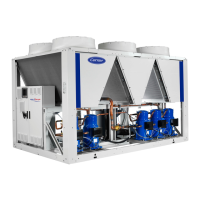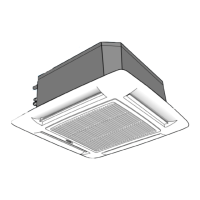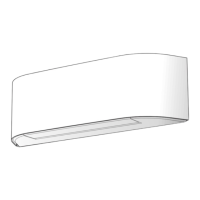41
1 2 3 4 5 6
A
Fans linked in pairs -
4 and 6-stage conguration (min. 2 - max. 8)
1 2 3 4 5 6
A
1 2 3 4 5 6
Legend
A Entering and leaving water manifold side
1 to 6 Fans
Pro-Dialog+ optimises system operation to obtain the best
efciency with variation of the water ow rate and the number
of fans required for any thermal load and outside temperature
conditions.
The electronic board (AUX1) integrated in the control box
of the drycooler has analogue inputs for outside air
temperature and drycooler leaving water temperature
sensors, as well as eight digital outputs permitting control of
up to eight fan stages.
14.3 - Conguration of the number of fan stages and
the automatic changeover of the fan stages
Please refer to the instructions in the 61WG/30WG/30WGA
Pro-Dialog+ IOM for the conguration of the number of fan
stages to be controlled. It is enough to enter the number of
fan stages of the drycooler in the Pro-Dialog+ service menu.
The number of digital outputs controlling the fans are activated
by the control.
Pro-Dialog+ controls the automatic switching of all fan stages,
based on operating time and number of start-ups of the
different stages. This function prevents fan motors from only
running a little or not at all and the shafts seizing up, especially
during periods with a low cooling demand, when the outside
temperature is low. Switching is often specified by the
drycooler manufacturers to ensure a long operating life of fan
motors that are only used a little or not at all in these
particular operating conditions.
14.4 - Fan stage assignment
The minimum conguration of the number of fan stages is 2
for correct operation.
Depending on the drycooler capacity the number of fans can
be between 2 and 8. They can be controlled by one fan or
by linked pairs, if necessary.
A drycooler with 4 or 6 fans installed in series for example
along the length of the unit will result in a conguration of
4 or 6 fan stages.
Reciprocally a drycooler with 8 or 12 fans arranged in pairs
along the length of the unit will also result in a conguration
of 4 or 6 fan stages.
Conguration with 4 and 6 stages (min. 2 - max. 8)
14 - 30WG UNIT OPERATION WITH A DRYCOOLER
(OPTION 154)
14.1 - Operating principle
30WG units have been specially designed to optimise the
operation of systems, using drycoolers as heat rejection
system.
With a variable-speed condenser water pump integrated into
the 30WG, the complexity of traditional systems, using a
three-way valve has been reduced.
The installation of an operational system is limited on the
condensing water loop side to connecting the drycooler
entering and leaving water piping to the 30WG unit.
The Pro-Dialog+ control of the 30WG includes algorithms
to permit constant automatic optimisation of:
• drycooler fan stage operation
• water ow rate variation in the loop between the
condenser and the drycooler.
Parallel control of the fan stages (up to 8 stages maximum)
and of the variable water ow rate of the loop permit year-
round system operation down to -10 °C outside temperature
without any additional control.
14.2 - Auxiliary electronic board (AUX1) - analogue and
digital inputs and outputs - to control the drycooler
R S V
CH
4
J7
CH
1
--
R S V
--
J2
--
CH13
CH
3
J4
CH
2
--
-- G +
CH
10
--
J5
T
P
V
CH14
3 2 1
--
3 2 1
CH
8
--
-- G +
CH
7
--
J6
CH14
CH
6
--
J8
CH
5
CH
9
• Connector J2: Digital outputs CH 1 to 4 for fan stages
1 to 4.
• Connector J3: Digital outputs CH 5 to 8 for fan stages
5 to 8.
• Connectors J4 and J5: Analogue outputs 0-10 V dc not
used on the drycoolers (only used for fan speed variation
of the air-cooled condensers).
• Connector J6: Analogue inputs CH 11 and 12 for dry-cooler
leaving water and outside temperature sensors.
• Connector J9: Communication bus with NRCP master
board of the 30WG unit.
The electronic board specically integrated in the control
box of the drycooler and a communication bus connected to
the microprocessor board of the 30WG is used for the overall
system control.
The option supplied with the cooling unit must be installed
in the drycooler control box. Connect the unit to board AUX1
in the drycooler, using a communication bus cable.

